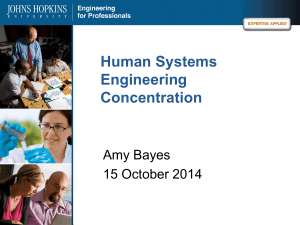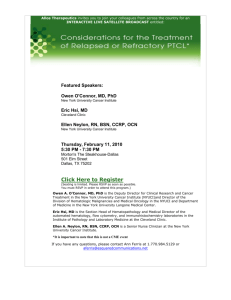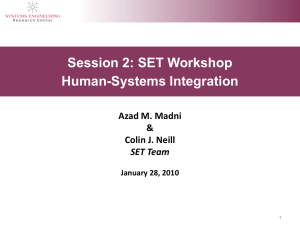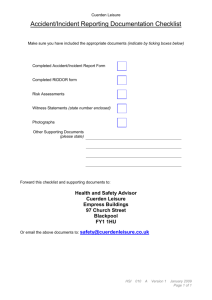Big Five Questions
advertisement
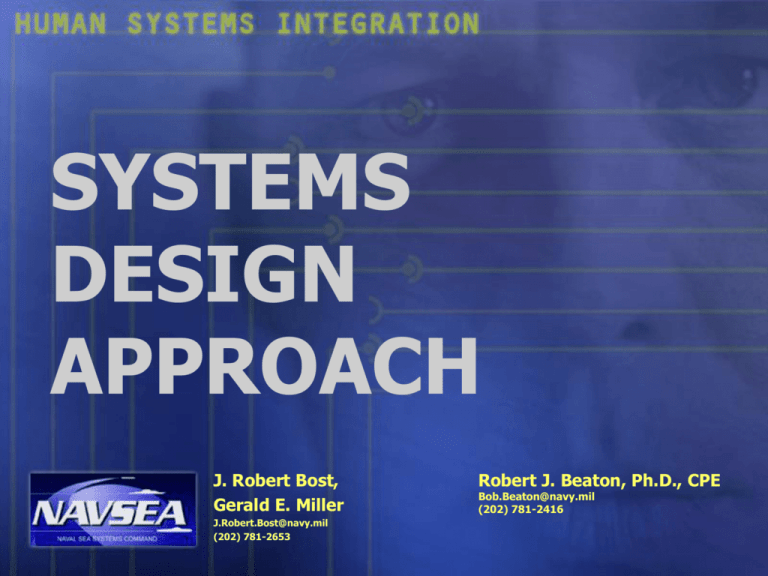
HSI 101 1/31/2005 PAGE 1 SYSTEMS DESIGN APPROACH J. Robert Bost, Gerald E. Miller J.Robert.Bost@navy.mil (202) 781-2653 Robert J. Beaton, Ph.D., CPE Bob.Beaton@navy.mil (202) 781-2416 HSI 101 1/31/2005 PAGE 2 Session Objectives After completing this session, you will be able to: • Understand HSI systems approach using “Big Five Questions” • Understand that human behaviors (efficiency & safety) have relationships to HSI principles • Recognize importance of physical design requirements in design of naval systems HSI 101 1/31/2005 PAGE 3 Session Outline Basic HSI Systems Design Approach Human Behavior/HSI Relationship Physical Design Requirements • Habitability • Safety Conclusions HSI 101 1/31/2005 PAGE 4 Once Upon a Time… • there was this processing facility… • and there was this conveyor belt that needed maintenance … • and there was this employee who did not properly lock-out and tag the conveyor … • and there was this arm … Was the accident really the employee’s fault? HSI 101 1/31/2005 PAGE 5 Examples HSI 101 1/31/2005 PAGE 6 The Big Five Questions What is user required to do to operate and maintain the equipment? • Specific tasks (calibrate, repair, remove, maintain) • Body postures required • Tools or test equipment required HSI 101 1/31/2005 PAGE 7 The Big Five Questions What is the user’s operating environment? • • • • • • • • • Temperature Air flow/Oxygen content Humidity Noise, vibration, and acceleration Toxic or noxious fumes Illumination Foot or equipment traffic Physical hazards Platform movement (vehicles, ships, planes) HSI 101 1/31/2005 PAGE 8 The Big Five Questions What is the potential worst case operating scenario? • Trained personnel not available • Unexpected environmental condition • Equipment used in an emergency HSI 101 1/31/2005 PAGE 9 The Big Five Questions Who is the user? • Gender (male, female) • Size (5th to 95th percentile) • Pre-selected or not screened • Age/Physical fitness • Mental abilities HSI 101 1/31/2005 PAGE 10 The Big Five Questions What training does the user require? • Formal training • Job experience HSI 101 1/31/2005 PAGE 11 Session Outline Basic HSI Systems Design Approach Human Behavior/HSI Relationship Physical Design Requirements • Habitability • Safety Conclusions HSI 101 1/31/2005 PAGE 12 Efficiency and Safety of Human Behavior People are efficient – we expend the least energy needed to accomplish a task in a perceived safe manner Equipment designs and procedures can induce safety conscious people into committing unsafe acts Equipment and procedures that do not match our cultural expectations eventually result in error HSI 101 1/31/2005 PAGE 13 Efficiency and Safety of Human Behavior If procedures or hazard signs are too complex, lengthy, or frequent, people tend to avoid reading them Conversely, if procedures are too simple, people ignore them If a sign is not readable or incomplete, people will guess Equipment that is easy to fix tends to work better and has higher reliability HSI 101 1/31/2005 PAGE 14 Efficiency and Safety of Human Behavior Equipment subject to misuse or poor maintenance increases the amount of non-work interaction between two or more people People judge how a control/display works based on the control/display shape, size, and orientation Our musculoskeletal system controls the direction and amount of manual force applied in completing a task HSI 101 1/31/2005 PAGE 15 Session Outline Basic HSI Systems Design Approach Human Behavior/HSI Relationship Physical Design Requirements • Habitability • Safety Conclusions HSI 101 1/31/2005 PAGE 16 Anthropometrics Location and size of equipment should assure easy operation and maintenance by personnel in 5th - 95th percentile or other defined (expected) population Physical demands on workers should be within the following limits: • Minimum overhead height/standing 75” • Minimum height for crawling 31” • Maximum overhead reach 77” • Maximum depth of reach 23” HSI 101 1/31/2005 PAGE 17 Walkways/Passageways Do not put items on either side of bulkheads within these areas 53-77 IN. (134.6-195.6 cm) PASSAGEWAY 0-38 IN. (0-96.5 cm) DECK HSI 101 1/31/2005 PAGE 18 Injury Potential: Poor Access or Design Valve stems extend into walkway Obstructions in walkways and emergency escape routes • Bulkhead mounted equipment • Low overhead pipes • Valve handwheels Inaccessible valves • Standing on pipes • Standing on equipment • Standing on handrails HSI 101 1/31/2005 PAGE 19 Workplace: Crawling Space Minimum mm in Preferred mm in Arctic Clothes mm in Q Height 785 31 910 36 965 38 R Length 1500 60 --- --- 1760 70 HSI 101 1/31/2005 PAGE 20 Workplace: Squatting Space Minimum mm in Preferred mm in Arctic Clothes mm in K Height 1220 48 --- --- 1290 51 L Depth 685 27 910 36 --- --- M Height 660 26 1020 40 1220 44 HSI 101 1/31/2005 PAGE 21 Workplace: Squatting Space Minimum mm in Preferred mm in Arctic Clothes mm in N Depth 1060 42 1220 48 1270 50 O Height 1420 56 --- --- 1500 60 P Depth --- --- 685 27 --- --- HSI 101 1/31/2005 PAGE 22 Living Space: Habitability Issues Concern for personnel safety and comfort in system design. Lighting Noise Vibration Temperature Humidity Airflow Atmospheric content Color Texture Access Privacy Hygiene Leisure activities Personal space Comfort HSI 101 1/31/2005 PAGE 23 Living Space: Habitability Standards Updated OPNAVINST 9640.1A Increases in berthing clearances • Vertical berth separation: from 18” to 20” • Horizontal separation: from 24” to 27” Maximum of six person cubicles Kickout panels for emergency escape from cubicles Limit color combinations HSI 101 1/31/2005 PAGE 24 Living Space: Past and Present USS Yorktown, 1943 Today USS Olympia, 1889 HSI 101 1/31/2005 PAGE 25 Living Space: Future Sit-up berth Stateroom HSI 101 1/31/2005 PAGE 26 Living Space: Trends in Habitability Standards Affordability Through Commonality (ATC) • Modular staterooms • Standard sanitary facilities • Use of commercial equipment and standards Food preparation/serving needs improvement Space for physical fitness/exercise Access to personal computers for leisure Clothing, small stores, accessories available at Ship’s Store HATCH HSI 101 1/31/2005 PAGE 27 Injury Potential: Poor Access or Design Inability to access emergency control Inability for personnel to operate control with gloves Inability for personnel to enter confined space with PPE Poor or missing labeling Effects of extreme environments HSI 101 1/31/2005 PAGE 28 Environment: Temperature Effect on Performance TEMP ºF PERFORMANCE EFFECTS 90 Upper limit for continued occupancy over any reasonable period of time. 80-90 Expect universal complaints, serious mental and psychomotor performance decrement, and physical fatigue. 80 Maximum for acceptable performance even of limited work; work output reduced as much as 40-50%, people experience nasal dryness. 78 Regular decrement in psychomotor performance expected; individuals experience difficulty falling asleep and remaining asleep. 75 Clothed subjects experience physical fatigue, become lethargic and sleepy, and feel warm; unclothed subjects consider this temperature optimum without some type of protective cover. 72 Preferred for year-round sedentary activity while wearing light clothing. *NOTE - These temperature effects are based on relatively still air and normal humidity (40 to 60%). Higher temperatures are acceptable if airflow is increased and humidity is lowered (a shift from 1 to 4o); lower temperatures are less acceptable if airflow increases (a shift upward of 1 to 2 o). HSI 101 1/31/2005 PAGE 29 Environment: Temperature Effect on Performance TEMP ºF PERFORMANCE EFFECTS 70 Midpoint for summer comfort; optimum for demanding visual motor tasks. 68 Midpoint for winter comfort (heavier clothing) and moderate activity, but slight deterioration in kinesthetic response; people begin to feel cool indoors while performing sedentary activities. 66 Midpoint for winter comfort (very heavy clothing), while performing heavy work or vigorous physical activity. 64 Lower limit for acceptable motor coordination; shivering occurs if individual is not extremely engaged in continuous physical activity. 60 Hand and finger dexterity deteriorates, limb stiffness begins to occur, and shivering is positive. 55 Hand dexterity is reduced by 50%, strength is materially less, and there is considerable shivering. 50 Extreme stiffness; strength applications accompanied by some pain; lower limit for more than a few minutes. HSI 101 1/31/2005 PAGE 30 Environment: Noise Effect on Performance NOISE dB PERFORMANCE EFFECTS 100 Serious reduction in alertness. Attention lapses occur. Temporary hearing loss occurs. 95 90 Upper acceptance level for occupied areas. Temporary hearing loss often occurs. Speech extremely difficult, and people required to shout. Half of the people judge the environment as being too noisy. Some momentary hearing loss occurs. Skill errors and mental decrements will be frequent. Annoyance factor high, and certain physiological changes often occur (for example, blood pressure increases). 85 Upper acceptance level in range from 150 to 1200 Hz. Some hearing loss occurs. Considered upper comfort level. Some cognitive performance decrement can be expected, especially where decision making is necessary. 80 Conversation is difficult. Difficult to think clearly after about 1 hour. May be some stomach contraction and an increase in metabolic rate. Strong complaints can be expected from those exposed to this level in confined spaces. 75 Too noisy for adequate telephone conversation. A raised voice is required for conversants 2 feet apart. Most people judge the environment as too noisy. HSI 101 1/31/2005 PAGE 31 Environment: Noise Effect on Performance NOISE dB PERFORMANCE EFFECTS 75 Too noisy for adequate telephone conversation. A raised voice is required for conversants 2 feet apart. Most people judge the environment as too noisy. 70 Upper level for normal conversation. Unprotected telephone conversation difficult. 65 Acceptance level for a generally noisy environment. Intermittent personal conversation acceptable. Half of the people will experience difficulty sleeping. 60 Upper limit for spaces used for dining, social conversation, and sedentary recreational activities. 55 Upper acceptance level for quiet spaces. Raised voices required to converse over distance greater than 8 feet. 50 40 Acceptable to most people where quiet is expected. About 25% will be awakened or delayed in falling asleep. Normal conversation is possible at distances up to 8 feet. Very acceptable to all. Recommended upper level for quiet living spaces. HSI 101 1/31/2005 PAGE 32 Session Outline Basic HSI Systems Design Approach Human Behavior/HSI Relationship Physical Design Requirements • Habitability • Safety Conclusions HSI 101 1/31/2005 PAGE 33 In this session, you have learned about: • HSI systems approach using “Big Five Questions” • Human behaviors (efficiency & safety) have relationships to HSI principles • Importance of physical design requirements in design of naval systems
